Cast * Interesting Facts * Production Details * Main Source for this Page: Nausicaa.Net
Cast * Interesting Facts * Production Details * Main Source for this Page: Nausicaa.Net
Original Title: Kaze no Tani no Naushika
 Directed
by: Hayao Miyazaki
Directed
by: Hayao Miyazaki
Written by: Hayao
Miyazaki
Music by: Joe Hisaishi
Production Period: May 31, 1983 - March 6, 1984
Released on: March 11, 1984 (Japan)
Running Time: 116 minutes
Budget: $
Box-Office: 914,767 admission, ¥742
million in film rental
 Nausicaä...
Sumi Shimamoto
Nausicaä...
Sumi Shimamoto
Jihl... Mahito Tsujimura
Oh-Baba... Hisako Kyouda
Yupa... Gorou Naya
Mito... Ichirou Nagai
Goru... Kouhei Miyauchi
Gikkuri... Jouji Yanami
Niga... Minoru Yada
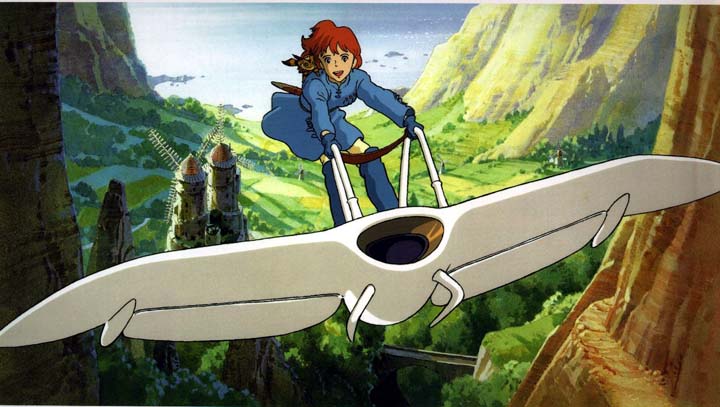
Nausicaä of the Valley of the Wind is a film that speaks
a great deal about our world. The story takes place sometime in the near
future where technology and pollution has virtually destroyed our Earth.
Poisonous forests named Fukai (poisonous seas) now cover many parts of
the Earth and its domination spread further and further each day.
The Valley of the Wind is one of the few places left where peace and nature
still exists. The Valley is sheltered from the wars and poison outside
because the village is protected by the wind from the sea which prevents
the poison from coming in. The people live happily and our Nausicaä
is the beloved Princess of this the Valley of the Wind.
Nausicaä dedicates her life to her people and strive to research
a cure to help those who suffer from Fukai poison. However, one day, the
lives of all those in the Valley are thrown into chaos. The people are
in danger of losing all that they have cherished so dearly, and it is up
to Nausicaä to save her people and the future of all mankind.
![]() Sumi Shimamoto (born
in 1954 in Kouchi), the Japanese voice of Nausicaä, is for many Miyazaki
fans, the voice of the Miyazaki heroine. She played Clarisse in Lupin
III: The Castle of Cagliostro, and Maki in Farewell Beloved Lupin.
She also played Satsuki's mother in My
Neighbor Totoro.
Sumi Shimamoto (born
in 1954 in Kouchi), the Japanese voice of Nausicaä, is for many Miyazaki
fans, the voice of the Miyazaki heroine. She played Clarisse in Lupin
III: The Castle of Cagliostro, and Maki in Farewell Beloved Lupin.
She also played Satsuki's mother in My
Neighbor Totoro.
![]() This movie was banned
from Eastern Europe and briefly boycotted in Germany, because enviromentalist
organizations were ranting that the film had disturbing scenery of ecological
disaster.
This movie was banned
from Eastern Europe and briefly boycotted in Germany, because enviromentalist
organizations were ranting that the film had disturbing scenery of ecological
disaster.
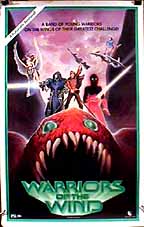
![]() The
only English version commercially available today is the horrendously mangled
"Warriors of the Wind" from New World Video. New World Pictures felt it
could only be marketed as a kid's action movie, so they cut out about a
quarter of the movie (the parts they felt were "slow moving") and garbled
the storyline in the process. Nausicaä was changed to "Princess Zandra".
The voice actors and actresses (including the June Foray, voice of "Rocky
the flying squirrel") said later that they were never told what the story
was about and so the acting was substandard. Miyazaki was horrified when
he found out what they had done to his film, and the Ghibli Studio asked
everyone to forget that this version ever existed. Fortunately, New World
Video's rights to Nausicaä expired in 1995. Disney is going
to release the newly dubbed version (uncut), though no official release
date was announced yet.
The
only English version commercially available today is the horrendously mangled
"Warriors of the Wind" from New World Video. New World Pictures felt it
could only be marketed as a kid's action movie, so they cut out about a
quarter of the movie (the parts they felt were "slow moving") and garbled
the storyline in the process. Nausicaä was changed to "Princess Zandra".
The voice actors and actresses (including the June Foray, voice of "Rocky
the flying squirrel") said later that they were never told what the story
was about and so the acting was substandard. Miyazaki was horrified when
he found out what they had done to his film, and the Ghibli Studio asked
everyone to forget that this version ever existed. Fortunately, New World
Video's rights to Nausicaä expired in 1995. Disney is going
to release the newly dubbed version (uncut), though no official release
date was announced yet.
![]() In Japanese, the heroine's
name is pronounced [Na u shi ka]. The proper pronunciation for Nausicaä
is [Nau-sik'a-e] (the last [e] is supposed to be upside down, pronounced
like [a] in ADORE, or [u] in SINUS).
In Japanese, the heroine's
name is pronounced [Na u shi ka]. The proper pronunciation for Nausicaä
is [Nau-sik'a-e] (the last [e] is supposed to be upside down, pronounced
like [a] in ADORE, or [u] in SINUS).
![]() Nausicaä of the
Valley of Wind received an award for Best Film at 1985's FantaFestival.
Nausicaä of the
Valley of Wind received an award for Best Film at 1985's FantaFestival.
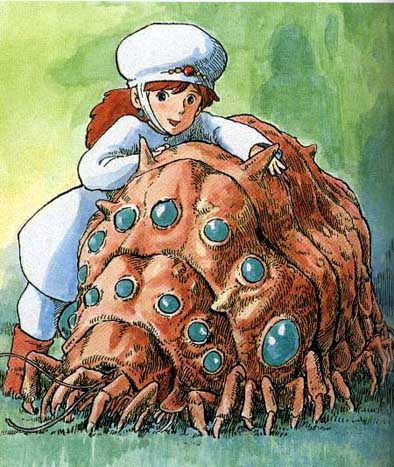 "The
Princess Who Loved Insects" is a story in "Tsutsumi Chunagon Monogatari",
which was written at the end of the 12th century. Miyazaki took an inspiration
from the princess in this story to create "Nausicaä". This princess
was quite eccentric - she didn't dye her teeth black, she didn't shave
her eyebrows off, and she was tanned since she actually went outside (this
is the equivalent of going around naked today). She loved insects and worms,
while other princesses loved butterflies. But she was incredibly intelligent
and perceptive. She said "Beauty is only superficial. You have to see the
real nature of things to understand them", and loved to watch caterpillars
changing into pupas. When her parents tried to persuade her to give up
her "hobbies", she replied, "To understand anything, you have to look into
it deeply, and see it through from the beginning to the end. This caterpillar
will become a butterfly someday. The silks you are wearing came from silkworms,
too."
"The
Princess Who Loved Insects" is a story in "Tsutsumi Chunagon Monogatari",
which was written at the end of the 12th century. Miyazaki took an inspiration
from the princess in this story to create "Nausicaä". This princess
was quite eccentric - she didn't dye her teeth black, she didn't shave
her eyebrows off, and she was tanned since she actually went outside (this
is the equivalent of going around naked today). She loved insects and worms,
while other princesses loved butterflies. But she was incredibly intelligent
and perceptive. She said "Beauty is only superficial. You have to see the
real nature of things to understand them", and loved to watch caterpillars
changing into pupas. When her parents tried to persuade her to give up
her "hobbies", she replied, "To understand anything, you have to look into
it deeply, and see it through from the beginning to the end. This caterpillar
will become a butterfly someday. The silks you are wearing came from silkworms,
too."
Hayao Miyazaki wondered how this princess survived as an adult, and what her fate had been. We can see the traits of this princess in Nausicaä.
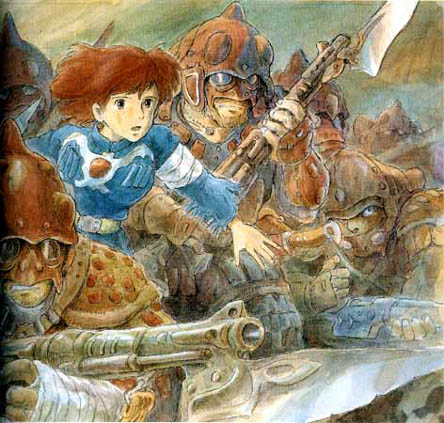 Nausicaä
was named after a Phaeacian princess in the Odyssey. Nausicaä was
"a beautiful and fanciful girl, quick on her feet... She took delight in
nature and had an especially receptive personality". She saved Odysseus
when he drifted ashore covered with blood and then nursed his wounds. Another
model for Miyazaki's Nausicaä was the "Princess Who Loved Insects".
It is an old Japanese story about a noble girl who was regarded as an eccentric
because she loved to watch insects.
Nausicaä
was named after a Phaeacian princess in the Odyssey. Nausicaä was
"a beautiful and fanciful girl, quick on her feet... She took delight in
nature and had an especially receptive personality". She saved Odysseus
when he drifted ashore covered with blood and then nursed his wounds. Another
model for Miyazaki's Nausicaä was the "Princess Who Loved Insects".
It is an old Japanese story about a noble girl who was regarded as an eccentric
because she loved to watch insects.
Nausicaä of the Valley of Wind is based on Miyazaki's manga, "Kaze no Tani no Nausicaä". There are seven volumes in total, and the movie covers about the first two volumes. He started serializing the manga "Nausicaä" in the animation magazine "Animage" in 1982.
At first, Miyazaki did not want to make "Nausicaä" into anime, since he wrote the manga to express something he couldn't express with animation, and since the manga was still at an introductory stage. As a result, the story of the film was substantially changed from the one in the manga.
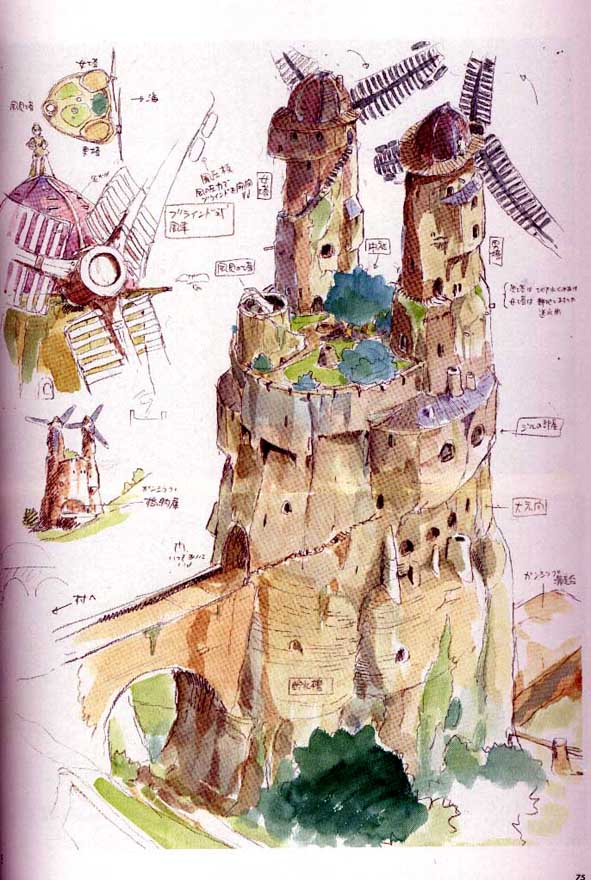 Miyazaki
took 13 years to finish this manga, though he did set the manga aside several
times to make movies. A great many things happen after what happened in
the movie. Even the part depicted in the movie is much more complicated
in the manga.
Miyazaki
took 13 years to finish this manga, though he did set the manga aside several
times to make movies. A great many things happen after what happened in
the movie. Even the part depicted in the movie is much more complicated
in the manga.
In the manga, there is a war going on between two superpowers, Torumekia and the Dorok Empire. Nausicaä was a part of Kushana's invading force, which she joined as the chieftain of the valley to keep the old treaty between Torumekia and the valley (so Torumekia was basically an ally, not an enemy). Most of the story then takes place in the land of Dorok. The Doroks are the ones who tried to cause the Ohmu stampede to crush Kushana's army to defend their land from the invasion. Nausicaä didn't even die at this point.
In the manga, there are no simple dichotomies such as valley vs. Torumekia, good vs. evil, or Nature vs. Man. Many characters, such as Kushana, Ghil, and the God Warrior have very different fates and roles than in the movie.
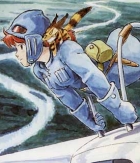 Though
some see a religious image in this resurection scene of the anime, Miyazaki
himself did not intend it so. In fact, he was hard on himself for giving
the movie an ending which looked "religious", and gave only 65 points out
of 100 to the movie because of that. Miyazaki had a strong aversion
to organized religions. He once said that he did not want to explain the
world based on a god. This may be due to his background in Marxism. However,
he seems to be "opening up" a bit more towards religion or spirituality
these days, largely because writing the manga "Nausicaä" required
him to think about philosophical questions such as "What is life?". However,
he doesn't belong to any cult or organized religion.
Though
some see a religious image in this resurection scene of the anime, Miyazaki
himself did not intend it so. In fact, he was hard on himself for giving
the movie an ending which looked "religious", and gave only 65 points out
of 100 to the movie because of that. Miyazaki had a strong aversion
to organized religions. He once said that he did not want to explain the
world based on a god. This may be due to his background in Marxism. However,
he seems to be "opening up" a bit more towards religion or spirituality
these days, largely because writing the manga "Nausicaä" required
him to think about philosophical questions such as "What is life?". However,
he doesn't belong to any cult or organized religion.
|
||||||||||||